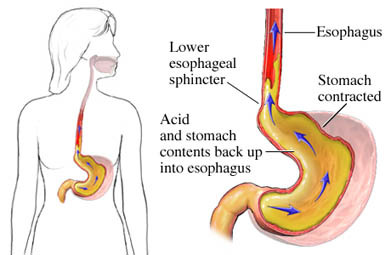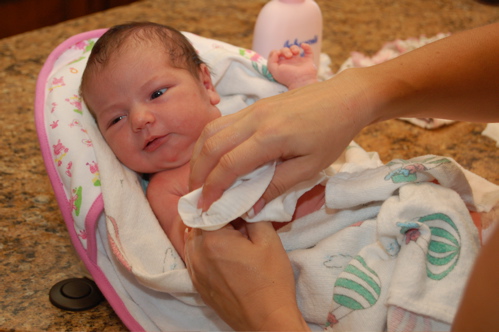Gastroesophageal Reflux in Children and Adolescents
What is gastroesophageal reflux?
Gastroesophageal reflux occurs when stomach contents flow back into the esophagus during or after eating. The esophagus is the food tube that connects the mouth to the stomach. Circular muscles at the end of the esophagus open and close to allow food to pass into the stomach. These circular muscles act as a valve at the entrance of the stomach and are called the Lower Esophageal Sphincter (LES).
Reflux can occur when the LES opens and allows acidic stomach contents to flow back up into the esophagus. Gastroesophageal reflux usually begins in childhood, but only a small number of children continue to have reflux as they grow up.
What are the signs and symptoms of gastroesophageal reflux?
Most children and adults have some reflux, usually unnoticed. When the returned contents in the esophagus quickly return to the stomach, they do not damage the esophagus. But in some cases, these acidic contents stay in the esophagus and start to damage its mucosa. When stomach contents returned in the esophagus pass into the mouth or enter the respiratory tract, children and adults begin to have a hoarse voice or chronic cough.
Other signs include:
- frequent pneumonia and bronchitis (due to the aspiration of stomach fluids into the respiratory tract)
- difficulty breathing
- difficulty or pain in swallowing
- vomiting
- sore throat
- weight loss
- heartburn (more pronounced in adults)
- Sensation of lump or soreness in throat

How is gastroesophageal reflux diagnosed?
You should consult a gastroenterologist, who specializes in treating digestive tract diseases. The doctor will gently ask about the signs, give you a thorough physical examination, and recommend tests that ultimately diagnose gastroesophageal reflux.
The most common tests to diagnose G-E reflux are:
*Contrast X-ray of the stomach. Where by means of X-rays, damages and the function of the lower esophageal sphincter (LES), stomach, or intestines can be seen. To perform this examination, you will first drink a white liquid called barium contrast, which helps in taking images under X-rays.
The doctor cannot diagnose only through contrast X-ray, but it helps in excluding other serious problems that cause the same problems as reflux.
* Endoscopy (gastroscopy). Before this procedure, the patient is given a sedative (venous sleep inducer). Then, through a thin flexible tube that passes through the mouth, continues into the esophagus, enters the stomach, and into the beginning of the small intestine in the duodenum. At its tip, it has a camera and a light. Also, inside it has a channel where other auxiliary tools for the doctor during the examination can pass, e.g.: biopsy forceps, hook for removing foreign bodies, etc.
Through this examination, the doctor can closely evaluate the mucosa of the esophagus, stomach, and duodenum. Also, during the examination, the doctor can take some cells for further examination (biopsy). By examining these cells under a microscope, it helps the doctor to see the damages caused by the return of gastric fluids and exclude serious problems.
* Esophageal pH-metry. A thin wire with an acid sensor at its tip is inserted through the nose to the lower part of the esophagus. This wire indicates the presence and measures the amount of stomach acid returned to the esophagus. It also shows the presence of acid in the esophagus when the child is crying, coughing, or when bending backward.
You should talk to your pediatrician when the following situations occur:
- When the number of vomits increases or strong vomits continue.
- vomiting with yellow or green color or that have the appearance of coffee sludge or blood.
- difficulty breathing after vomiting or regurgitations (return of small amounts of food in children's mouth)
- pain related to feeding
- refusal of food resulting in weight loss or poor weight gain
- difficulty and pain in swallowing
What is the treatment for gastroesophageal reflux?

The treatment of reflux depends on the signs that children and adults have. The main goal of medical treatment for reflux is to reduce the acidity of the stomach fluids.
Besides medication, it is important to follow some practical advice, such as for children, parents should keep in mind:
- the child should eat frequently and small amounts of food.
- avoid feeding the child 2-3 hours before bedtime.
- Raising the head of the bed a few centimeters higher so that the child's head and neck are higher than the rest of the body. Adding some pillows does not solve the problem.
- Avoiding carbonated drinks, chocolates, and juices that contain a lot of acid like orange juice.
Diet for Esophagitis from Reflux
- Avoid smoking and alcohol.
- Avoid the use of mint gum and mint candies
- Do not lie down immediately after eating and avoid late dinners.
- Avoid wearing tight clothes and bending over after eating.
- Eat little and often
- Lose weight if you are overweight.
- The head of the bed where you sleep should be raised a few centimeters higher.
- The following foods aggravate reflux, so they should be avoided;
- Fatty foods
- Spicy and minty foods
- Chocolates
- Fast food
- The following foods irritate the inflamed esophagus and should be avoided or limited.:
- a) citrus fruits and juices, citrus (Orange, lemon, mandarin, pineapple)
- b) Coffee (regular and decaffeinated)
- c) Tea
- Spicy and acidic foods may be intolerable for some patients.
If medications and dietary advice do not improve the situation, surgery is recommended, although it is very rare in children.
If surgery is recommended in adults, a fundoplication is performed, where the upper part of the stomach is wrapped around the lower esophageal sphincter (LES). This procedure increases pressure on the LES and reduces the return of acidic fluids.